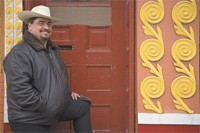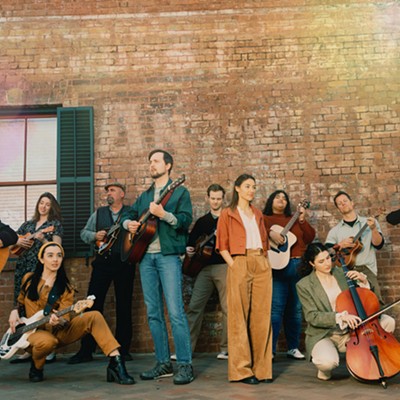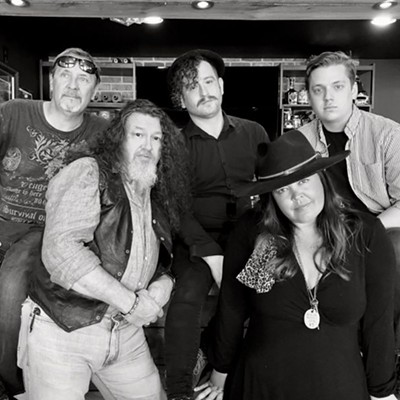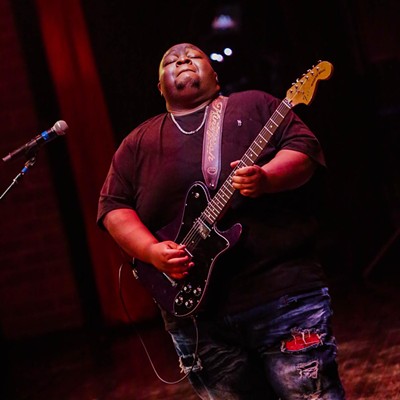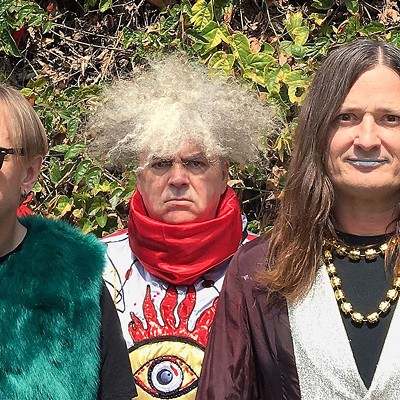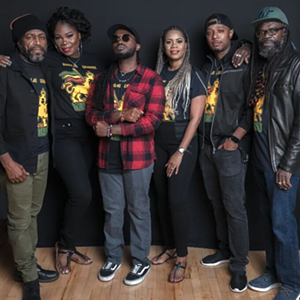THE FOLLOWING ARE EXCERPTS FROM MY EXTENDED DISCUSSION with musicologist and musician Juan Diés in advance of his group Sones de México’s free Sept. 25 appearance at Trustees Theater, courtesy of the City of Savannah’s Cultural Affairs Dept. and AASU’s HOLA program.
You’ve been involved in leading this group since its inception almost 15 years ago. Can you imagine yourself starting this group now, in today’s musical and political climate, and if so, how would that group likely differ from the one that began in 1994?
Juan Díes: (Laughs) Well, if we started this group now, knowing what we know today, we would probably avoid many mistakes, and we would probably not take as long getting here as we have. I think anyone could say that about his or her life! But I think I know what you are trying to get at. Fifteen years ago, we lived in a different America: a more innocent one. Musically, technology has shifted in the direction that empowers independent artists, like us. I think we have more access today. In 1994, the internet was in diapers: we didn’t have websites to speak of, downloadable music, CD-Rs, MySpace, e-blasts nor text messaging. We still licked stamps on postcards to get people to our shows, tried to get our records sold on consignment at Tower Records (five at a time), and we recorded our demos on cassette tapes.
Politically speaking I can’t say that we have experienced the same kind of progress. The words “immigrant” and “terrorist” were not used in the same sentence nearly as often. When we started the band, arts organizations brainstormed about ways to ethnically diversify their audiences as a means of enriching themselves. We could fly the talented Buéna Vista Social Club musicians from Cuba for a festival or a cultural exchange with a relatively simple and affordable application process. Now this is no longer possible. Fifteen years ago, people and the media were concerned about their political “correctness.” And now the same “correctness” is thought of as an undesirable quality.
But how has this changing political climate affected our music? Well, our music was not political when we started the band, but now at least some aspects of it have become political, in particular our cover of Woody Guthrie’s “This Land Is Your Land.” We didn’t plan it as an agenda for the band, but (at the same time) we just couldn’t ignore everything that was going on in this national debate over immigration.
Until reading your press materials, I was unaware of the large Mexican population of the greater Chicago area. As Chicago has a very strong musical heritage in its own right, tell me a bit about how those two unique dynamics may (or may not) relate to one another in the context of this group’s own music.
Juan Díes: Many people are unaware of the actual magnitude of our Mexican community in Chicago. It is second only to Los Angeles in the USA. In general, when people think of Latinos in he U.S., they first think of New, York, Los Angeles, Miami and Texas. Yet, our community has a history that dates back to the 19th Century, and numbers close to two million people today.
Chicago’s Latino community is mostly Mexican, and it has remained surprisingly close to Mexican traditions even though, geographically, it is so far from Mexico. Unlike Latino communities elsewhere, including some that are next to the Mexican border, we have not developed new, hybrid identities to speak of, like the “chicano,” “newyorican,” “tejano,” “cholo,” or “pocho.” Mexicans in Chicago, remain close to, not only Mexican traditions, but to micro-cultural customs from rural towns and villages where these immigrants come from.
Musically speaking, Chicago is home to at least 30 mariachi bands that I can think of, two or three 16 to 20-piece brass bands, many norteño groups, and hundreds of grupero and banda groups. But back in 1994, nobody was playing “son.” There were dozens of ballets folclóricos —folk dance companies who dance “son”— but they were all dancing to recorded music or mariachis. There were a couple of Veracruz-style harpists then: Beto Laguna and Jorge Jasso, but they were not doing much beyond restaurant table-strolling.
Victor Pichardo, a veteran of Mexican son, had just moved to Chicago for a teaching residency at Urban Gateways (an arts organization). I had also just moved to Chicago to take a post at the Old Town School of Folk Music. I was mainly playing corridos (Mexican ballads) at the time. But we met, and in 1994, Victor introduced me to Mexican son. He brought a friend and I brought another, and the four of us started rehearsing daily, while consuming about a case of beer per rehearsal! (laughs)
It so happened that I had a solo gig booked playing corridos for an art exhibit at Taller Mexicano de Grabado, in Chicago’s South Side, commemorating Emiliano Zapata death. I invited my new friends to the gig in order to test-run a couple of our new songs together. People were blown away. They asked us for the name of the band and business cards, but we had none yet. This happened on April 9, 1994. We consider this to be the birth of Sones de México Ensemble.
I got a big kick out of the Zeppelin cover on the latest record, and I assume that has drawn a good amount of attention. Tell me a bit about how that track came together, and if there was any trepidation from within the band’s ranks that it might be seen as merely a novelty.
Juan Díes: Our cover of Led Zeppelin’s “Four Sticks” grew out of an invitation to participate in a Led Zeppelin tribute at the Old Town School of Folk Music, involving many local musicians and bands. When you RSVP’d you also had to pick a song in order to avoid any repetitions during the show. We decided that we wanted to participate, but we didn’t know what song to do.
You see, Led Zeppelin is a very “blues”-based band, and the particular “swing” of the blues is not a common denominator with Mexican folk music. We knew a lot of Zeppelin’s music, but none was quite a match. We threw around some ideas like “The Immigrant Song” or “Bron-Yr-Aur Stomp,” but we were not quite happy with them. I suggested “Four Sticks” in a very percussive arrangement, mixing foot-tapping and son jarocho instruments: jarana, requinto, leona and drums. The piece alternates between contrasting sections in 5/8 and 6/8 rhythms. At one point, we considered a finale that transitioned into the theme for Mission Impossible, which is also in 5/8, but we thought this would go too far into the novelty arena. So, even though it was my arrangement, Victor gave that idea the thumbs down.
We performed the song live, and we got a good reception from the audience. Later, when we decided to record it on our new album, I reworked the arrangement and turned into an Aztec ceremonial dance to include the powerful percussion battery of huehuetl, teponaztli, ayoyotes and a slew of conchas (mandolins), conch shell horns, ocarinas and assorted indigenous percussion instruments. Only the requinto, the leona and the jarana remained from the first son jarocho arrangement. You can see a full list and pictures of the instruments in the booklet that comes with the CD. Clearly a hybrid in every respect, the song has become one of our bigger sellers on iTunes.
The band can play the song live without a problem, but lately it has become more of a rarity at our shows because the instrumentation requires that we haul a set of instruments that is only used in this one song, and a new set of channels on the mixing board that maxes-out the capabilities of some halls. In order to replicate the studio version of the song, we have also resorted to a couple of signal processing effects on a couple of acoustic instruments and those effects are also a challenge to some engineers who are not familiar with the band. Rather than risk a technical error in the middle of the song, we have shelved it for a while until we figure out a solution. There’s a video documentary by Gearwire on the making of this song, and you can find it in one of our YouTube Channel Playlists (see youtube.com/sonesdemexico).
In this day and age, when so many of the borders that once divided us as people are being broken down by global forms of communication, how important is it to preserve and maintain indigenous traditions of art and music, and where does your group fit into that notion?
Juan Díes: Globalization is a double-edged sword. Modern communications are truly a modern marvel, and they have certainly had a global impact on culture worldwide.
The geographic isolation between settlements of people around the world for the length of human existence is clearly responsible for the emergence of distinct cultures, and even distinct races. Nowadays, as those barriers disappear, a new challenge is created in people’s search for identity. The images, role models, and reference groups you use to shape your world view may come from anywhere.
The balance between the traditional ways and the alternatives that people around the world now have the “choice” to maintain is no different than the creative circumstance that Sones de México Ensemble finds itself in. We have chosen to ground ourselves in a good knowledge of our culture and to provide the opportunity for others to join us in that quest. But at the same time, we have chosen not to close ourselves up to attractive propositions in our multi-cultural surroundings, so long as we are given an opportunity to digest them and make them our own.
I was struck by one sentence in your press bio, in which the point was rather succinctly made that there is SO much more to Mexican culture than “Spring Break and margaritas”. I’m sure that this crass commercialization of the Mexican culture by American advertisers must be frustrating if not infuriating to Mexicans — especially those such as yourself who are keenly interested in preserving and promoting the many facets of history and the nuance of your culture’s diverse traditions. What sort of response has your band received from folks who are completely unaware of the breadth of Mexican culture, and how much importance do you place on your group’s role as ambassadors of that history as opposed to merely being an impressive, tight band that puts on great shows and makes strong albums?
Juan Díes: I think that our main response to the unashamed display of ignorance about Mexico that some people display has been to become educators. Besides being a touring band and recording albums, Sones de México Ensemble is also a non-profit arts organization devoted to teaching and researching Mexican music, dance, and culture. We do a lot of work as educators and consultants.
I have a lot of respect for someone who admittedly doesn’t know something and asks a sincere question because they want to learn. I will spend an inordinate amount of energy and time to try to satisfy their curiosity. At the same time, I do not have the same patience for someone who is content with a shallow view of our culture, and I pray that such person never gets a decision-making position over me and my compatriots.
It seems as though most of your regional fan-base in the Chicago area is made up of Mexicans or Mexican-Americans, but how about on the road? Are you drawing all sorts of crowds, or do you find that the majority of folks who come out to the gig are somehow directly involved with Mexican culture?
Juan Díes: I think that Sones de México Ensemble offers different things to different people. It is interesting that none of our albums has had a clear “hit single.” The range of what people name as their favorite songs on each album is very broad. To me, that is a great success. It means we speak to many different people.
Likewise, our audience is not monolithic: we have Mexican immigrants who long for a taste of home and hire us to play in a wedding; we have second generation Mexicans (U.S.-born children of immigrants) who feel their mother culture was denied to them and avidly seek a real connection; we have other Latin Americans who appreciate Mexican folk music and understand our lyrics and thus have their own connection; we have people who like “world music” and are eager to discover new sounds that they have never heard before and move in new ways with music that will inspire them to dance differently; we have people who like acoustic music or string-band folk and appreciate the similarities between Appalachian, Irish, Scottish tunes and our own. We also touch some political activists who focus on Latin American issues, and for whom our music, whether political in content or not, is an assertion of Latin American pride and culture with a high level of artistry. Then again, we also appeal to people who like classical music, progressive rock, salsa and other styles who find a single tune of ours that talks to them.
Interestingly enough, Mexican radio and television in the U.S. do not play our music. They seem to have some kind of “payola” system. We, as independents, have not been able to break into those mediums, even though we can count several of the program hosts among our fans. On the other hand, National Public Radio outlets and college and community radio stations have been our best vehicles to reaching listeners around the country. This has also contributed to reaching a more diverse —and not always Mexican— crowd.
In this U.S. election cycle, perhaps more so than at any other time, immigration issues are on voters’ minds. Your retooling of the classic Guthrie ballad “This Land is Your Land” is a provocative statement, but one that I’m a bit unclear on. Your press release mentions that it “takes on new meaning in light of today’s debates about immigration in the U.S.A.” What exactly do you see that new meaning as being? Is it truly different from the one which Woody initially sang, or are you merely re-introducing the song to a generation far removed from the tune? Does Sones de Mexico take an explicit stand on the subject of immigration in regards to Mexico and the U.S.A.?
Juan Díes: As I understand it, Woody Guthrie wrote “This Land Is Your Land” both as a reactionary retooling of the patriotic song “God Bless America,” and as a criticism of the treatment of migrant Okies rejected from California agricultural field working jobs during the Dust Bowl Era exodus by being told to “go back to their land.” The song was a protest song by both counts.
I felt it was interesting (and possibly inspiring) that with the passage of time, the song had become a patriotic song sung by school children, for generations all across America. It had become an American folk song in its own right! The message is very beautiful, and it resonates with the spirit of the Founding Fathers of this nation to create a land of opportunity unhampered by religious or class limitations —later on, gender and race were added too— on people’s right to succeed. In the years following the September 11, 2001 bombings by terrorists, people all over the nation began a debate over immigration policy, which was a long-neglected subject and a real mess — though not related to any count of terrorism. Hearing the anti-immigration statements expressed, especially coming from people who called themselves the most patriotic, seemed ironic to me. So that’s when Guthire’s song began to resonate in my head. Singing it in Spanish just felt like it exposed this incongruent, double-standard of patriotism. The “provocative statement” that you talk about is not in the song; it is in the subtext created by how the song is sung in the times in which we’re now living. A lot of people “get it.”What do you see as the next logical step for this band, either stylistically or in terms of outreach to different listening demographics?
Juan Díes: Our next album will be for children. A dual-language, double-CD set for children growing up in two parallel worlds. It is a children’s record that does not underestimate the intelligence and genius of kids’ imaginations.

